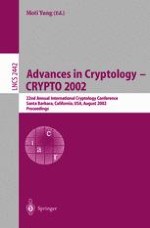2002 | OriginalPaper | Buchkapitel
Flaws in Applying Proof Methodologies to Signature Schemes
verfasst von : Jacques Stern, David Pointcheval, John Malone-Lee, Nigel P. Smart
Erschienen in: Advances in Cryptology — CRYPTO 2002
Verlag: Springer Berlin Heidelberg
Enthalten in: Professional Book Archive
Aktivieren Sie unsere intelligente Suche, um passende Fachinhalte oder Patente zu finden.
Wählen Sie Textabschnitte aus um mit Künstlicher Intelligenz passenden Patente zu finden. powered by
Markieren Sie Textabschnitte, um KI-gestützt weitere passende Inhalte zu finden. powered by
Methods from provable security, developed over the last twenty years, have been recently extensively used to support emerging standards. However, the fact that proofs also need time to be validated through public discussion was somehow overlooked. This became clear when Shoup found that there was a gap in the widely believed security proof of OAEP against adaptive chosen-ciphertext attacks. We give more examples, showing that provable security is more subtle than it at first appears. Our examples are in the area of signature schemes: one is related to the security proof of ESIGN and the other two to the security proof of ECDSA. We found that the ESIGN proof does not hold in the usual model of security, but in a more restricted one. Concerning ECDSA, both examples are based on the concept of duplication: one shows how to manufacture ECDSA keys that allow for two distinct messages with identical signatures, a duplicate signature; the other shows that from any message-signature pair, one can derive a second signature of the same message, the malleability. The security proof provided by Brown [7] does not account for our first example while it surprisingly rules out malleability, thus offering a proof of a property, non-malleability, that the actual scheme does not possess.
